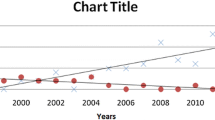Abstract
Purpose
To evaluate association between clinical and pathological findings and repeated recurrence in sinonasal inverted papilloma.
Methods
Retrospective cohort study conducted at a tertiary care teaching hospital included all patients operated for inverted papilloma from January 2010 to December 2019. Patients were categorized as primary and recurrent cases. Based on disease status at follow-up, they were subcategorized into ‘primary with no recurrence’ (PnR), ‘primary with recurrence’ (PwR), ‘recurrent with no further recurrence’ (RnR), and ‘recurrent with further recurrence’ (RwR) groups. Data including demography, clinical, endoscopic and pathological findings were collected and analyzed.
Results
Increased incidence of pale appearance of lesion in RnR group (p = 0.017), polypoidal appearance in primary group (p = 0.002) and fibrous appearance in the recurrent group (p = 0.002) were statistically significant. Predominant epithelium was combined respiratory and squamous epithelium in primary and recurrent groups and also in RnR group (p = 0.019), while it was squamous (p = 0.024) in RwR group. Epithelial hyperplasia was more common in primary and RnR groups. Oncocytic change, cystic dilatation, microabscess and squamous metaplasia were seen more in recurrent and RnR groups. Cytoplasmic glycogenation was more in recurrent and RwR groups. Stroma was predominantly edematous in all the groups.
Conclusions
Patients with recurrence are younger and present earlier than those with primary disease. Fleshy appearance and pink/red colour of tumour, lining epithelium being squamous and cytoplasmic glycogenation could be considered as features predicting recurrence. Negative predictors of recurrence of IP include pale appearance of tumour, combined respiratory and squamous epithelium lining and squamous metaplasia.





Similar content being viewed by others
References
Barnes L, Eveson J, Reichart P, Sidransky D (2005) World Health Organization Classification of Tumours. Pathology and genetics of head and neck tumours. IARC Press, Lyon
Ward N (1854) A mirror of the practice of medicine and surgery in the hospitals of London. London Hosp Lancet 2:87–99
Ringertz N (1938) Pathology of malignant tumours arising in the nasal and paranasal cavities and maxilla. Acta Otolaryngol 27:31–42
Nowosielska-Grygiel J, Pietkiewicz P, Owczarek K, Olszewski J, Miłoński J (2017) Diagnosis and treatment of nasal and paranasal inverted papillomas—epidemiology and own experience. Otolaryngol Pol 71(6):27–32
Lisan Q, Laccourreye O, Bonfils P (2016) Sinonasal inverted papilloma: from diagnosis to treatment. Eur Ann Otorhinolaryngol Head Neck Dis 133(5):337–341
Batsakis JG, Suarez P (2001) Schneiderian papillomas and carcinomas: a review. Adv Anat Pathol 8(2):53–64
Lisan Q, Moya-Plana A, Bonfils P (2017) Association of Krouse classification for sinonasal inverted papilloma with recurrence: a systematic review and meta-analysis. JAMA Otolaryngol Head Neck Surg 143(11):1104–1110
Coutinho G, Marques J, Leal M, Spratley J, Fernandes MS, Santos M (2020) Surgical outcomes of sinonasal inverted papilloma: a 17 year review. Braz J Otorhinolaryngol 86(3):315–320
Busquets JM, Hwang PH (2006) Endoscopic resection of sinonasal inverted papilloma: a meta-analysis. Otolaryngol Head Neck Surg 134:476–482
Jurado-Ramos A, Jodas JG, Romero FR, Linares EA, Del Castillo FM, Gomariz EM et al (2009) Endoscopic medial maxillectomy as a procedure of choice to treat inverted papillomas. Acta Otolaryngol (Stockh) 129:1018–1025
Jardine AH, Davies GR, Birchall MA (2000) Recurrence and malignant degeneration of 89 cases of inverted papilloma diagnosed in a non-tertiary referral population between 1975and 1995: clinical predictors and p53 studies. Clin Otolaryngol Allied Sci 25(5):363–369
Suh KW, Facer GW, Devine KD, Weiland LH, Zujko RD (1977) Inverting papilloma of the nose and paranasal sinuses. Laryngoscope 87(1):35–46
Roh HJ, Mun SJ, Cho K-S, Hong S-L (2016) Smoking, not human papilloma virus infection, is a risk factor for recurrence of sinonasal inverted papilloma. Am J Rhinol Allergy 30(2):79–82
Katori H, Nozawa A, Tsukuda M (2006) Histopathological parameters of recurrence and malignant transformation in sinonasal inverted papilloma. Acta Otolaryngol (Stockh) 126(2):214–218
Gamrot-Wrzoł M, Sowa P, Lisowska G, Ścierski W, Misiołek M (2017) Risk factors of recurrence and malignant transformation of sinonasal inverted papilloma. Biomed Res Int 2017:9195163
Wassef SN, Batra PS, Barnett S (2012) Skull base inverted papilloma: a comprehensive review. ISRN Surg 2012:175903
Vrabec DP (1994) The inverted Schneiderian papilloma: a 25-year study. Laryngo-scope. 104:582–605
Zhao L, Li CW, Jin P et al (2016) Histopathological features of sinonasal inverted papillomas in Chinese patients. Laryngoscope 126(4):141–147
Lee JJ, Roland LT, Licata JJ, Orlowski HLP, Jiramongkolchai P, Piccirillo JF, Kallogjeri D, Klatt-Cromwell CN, Chernock RD, Schneider JS (2020) Morphologic, intraoperative, and histologic risk factors for sinonasal inverted papilloma recurrence. Laryngoscope 130(3):590–596
Funding
This study received no funding.
Author information
Authors and Affiliations
Contributions
Research and study design: LV, BA, MT, RK. Data collection and analysis: RRB, RK, TRB, MT. Interpretation and conclusion: RRB, LV, RK, TRB, LMC, BA, MT, VR, RK. Preparation of manuscript: RRB, LV. Review of manuscript: RRB, LV, RK, TRB, LMC, BA, MT, VR, RK. Guide and critical revision: LV, LMC, MT, VR, RK. Administration: LV, BA, MT. Technical support: LV, RK, TRB, LMC, BA, MT, VR, RK.
Corresponding author
Ethics declarations
Conflict of interest
The authors declare that they have no conflict of interest to disclose. The authors alone are responsible for the content and writing of the paper.
Ethical approval
All procedures performed in this study were in accordance with the ethical standards of the institutional research committee and with the 1964 Helsinki declaration and its later amendments or comparable ethical standards. Institutional review board approval was obtained prior to the commencement of the study (IRB number: 13249).
Additional information
Publisher's Note
Springer Nature remains neutral with regard to jurisdictional claims in published maps and institutional affiliations.
Rights and permissions
Springer Nature or its licensor holds exclusive rights to this article under a publishing agreement with the author(s) or other rightsholder(s); author self-archiving of the accepted manuscript version of this article is solely governed by the terms of such publishing agreement and applicable law.
About this article
Cite this article
Bright, R.R., Varghese, L., Kurian, R. et al. Clinicopathological predictors of repeated recurrence in sinonasal inverted papilloma. Eur Arch Otorhinolaryngol 280, 1191–1199 (2023). https://doi.org/10.1007/s00405-022-07585-3
Received:
Accepted:
Published:
Issue Date:
DOI: https://doi.org/10.1007/s00405-022-07585-3




